
Advertisers sang Rosies praise, proudly applauding the “resourcefulness and ingenuity of American Women.”
Once upon a time, women workers were not only highly sought after they were lavished with praise in the media.
During WWII when Uncle Sam came calling, American women didn’t just “lean in,” they manned up!
Uncle Sam had enlisted the real Mad Men of Madison Avenue to conduct a massive campaign to recruit women into the work force.
The advertising campaign – as fierce as any battle on the front lines-was set in motion immediately after Pearl Harbor to not only mobilize women on the home front and get them into the work force but to help shape cultural attitudes.
Operation: Rosie the Riveter

Homemaker to Parachute Maker (R) Vintage ad Wheat Sparkies Cereal 1942 “Eat Breakfast the Victory Way like thousands of new production champions, like Mary Purdue valued worker at one of our largest parachute plants.”
Seemingly overnight, a plethora of ads appeared in all the major magazines glorifying the working woman.
A public more accustomed to seeing their women depicted in dainty dresses while luxing the family dishes, were now being bombarded with images of g0-getter gals dressed in cunning coveralls and bright bandanas lending their visage to hawk everything from soda pop to cigarettes.
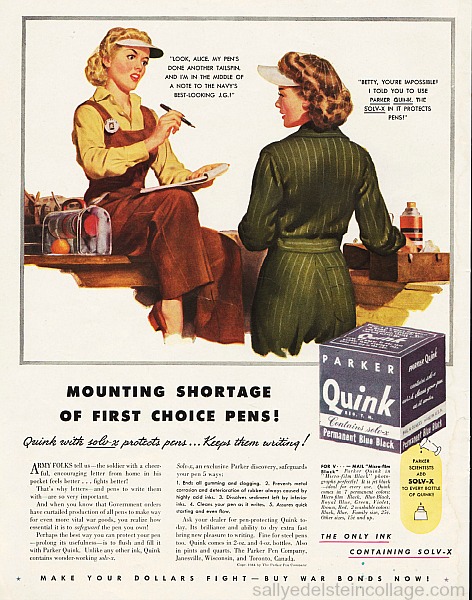
Rosie writes her beau in the service on her lunch break at the defense plant Vintage WWII ad Quink Ink 1943

Vintage WWII ad Camels Cigarettes 1943 ” Betty Boeing and Hal Ecker have several things in common. The both work on M-4 tanks at the Army Ordinance proving ground in Md. Both know a chap named Joe who drives an M-4 and both smoke Camels”

Whether working the swing swift or regular shift, war work requires extra energy. Get a lift from coffee or sugary drink. (L) Vintage ad 1944 Coffee Institute (R) Vintage WWII ad Orange Crush Soda 1943
With the speed of a blitzkrieg old notions about women’s proper place were swiftly decimated as women took to manning jobs in record numbers.
You’re a Good Soldier Mrs America
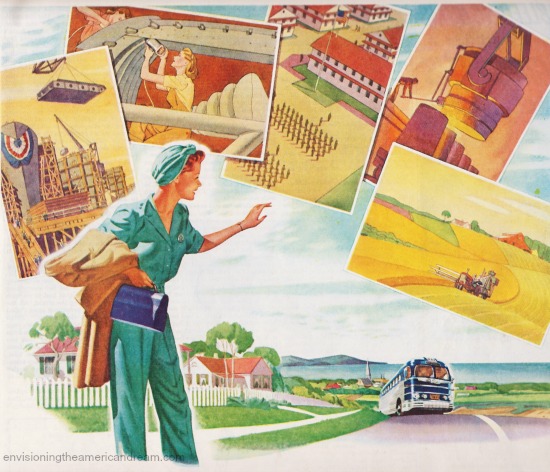
Rosie the Riveter rides the Bus. “Trips by Greyhound this summer?” this vintage Greyhound Bus ad begins. “The majority of Greyhound passengers today are war workers in uniform.”
During the war hundreds of men were leaving civilian jobs everyday to join the armed forces.
In their place marched in women, who were “carrying on,” performing work that had to be done to keep America’s war program going at top speed.
Replacing men in hundreds of jobs never previously open to them, these “gals were soldiers too,” helping us win the war and maintaining the American Way of Life.
Who Says This is a Mans War?
With great gumption these women took on tasks once considered unladylike, such as tending blast furnaces in steel mills, welding hulls in shipyards, running forklifts and working overtime on the riveting machine.
In the 1942 ad above, General Electric proudly exclaims: “There is no ‘Male Help Only ‘ sign in this war! Never before in American history have so many women been called upon to give so much of their time and energy to war effort.”
Uncle Sam Wants You
No effort was spared to get those ladies out of their flowered aprons and onto the assembly line.
In a 1943 ad prepared in cooperation with the War Advertising Council housewives were scolded: leave your afternoon bridge games and get out and get a job to help the war effort:
Must bullets whine and sirens shriek before all American women realize that the time is here. The time for them to get out and drive a truck, load a freight car, carry a waitress tray, work in a day nursery, operate an elevator?
It goes on to explain
It isn’t pleasant, no! But neither is war. And the war won’t be won unless our men abroad fighting are backed up by our women at home, working.
Sister Can You Spare an Hour?
“Read the want ads in your home paper to see what war jobs there are for women in your area, then register at your local U.S. Employment Service. There are paying jobs in many areas with training for the inexperienced. Get out and work, 4 hours, 8 hours, 10 hours if you can…but work…and stick to it till the war is won.”
It ends on a somber note:
The idle woman will be a very lonely soul this year!
The More Women at Work – the More We’ll Win
Some advertisements were designed specifically to attract women to war work. Many companies that advertised no longer produced consumer goods due to war production demands so ads also served as a way to keep their name in public eye.
Due to the paper shortage for example, Kleenex found itself with little wares to sell to the public, freeing them up to play a major part in the “Women at War Campaign.
Their series of ads went a long way towards convincing the public that a woman’s contribution was vital and nothing to sneeze at!
Girl Power
Initially the question was not “should women work?” but rather a series of questions: What sort of work should women do? Would they require special pampering and frills, should they get paid as much as men; would they become “mannish or or worse…create a distraction for men in the factories?
When Man Power Goes to War

Before our sailor ships off he offers some advise about the mimeograph machine : “Treat her right little girl- can’t get new ones as easy as we used to.” Vintage ad Mimeograph Duplicators 1942
Most thought women could do anything, that is as long as it didn’t require too much physical effort or too heavy or highly skilled operations.
Imagine that! Girls were now operating mimeograph machines! a surprised public learns in this ad.
In offices women left their typewriters and tackled the less feminine mimeograph machine, apparently something above her normal skill set.
“Were telling a lot of the boys goodby these days,” begins this ad from 1942. “Women and girls are taking over in offices with a march song on their lips courage in their heats ability in their hands.”
You Go Girl
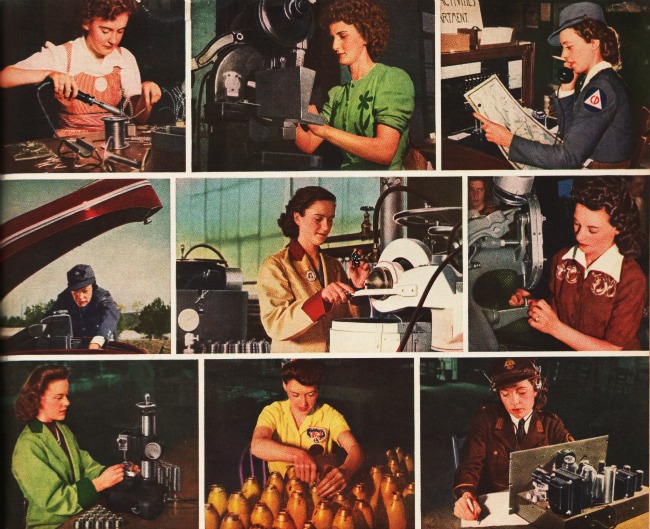
The surprise was not that women could do such jobs, but the fact that anyone was surprised they could perform so well. By the fall of 1943, 17 million women workers made up 1/3 of the total US workforce
But in fact, there was little women didn’t or couldn’t do.
Rosie the Riveter was joined by Winnie the Welder, Sheila the shell loader, Carol the Crane operator, Bessie the Bus driver and Flossie the filling station jockey, to name just a few.
Women Keep em’ Rolling
The ads all made drove home the point that women they were essential in keeping the American way of life.
By joining the ranks of fighting men, working shoulder to shoulder with men, these ads cast women in the long tradition of heroines who helped men in wartime and “helped build the kind of America we are fighting for today.”
In this 1944 vintage ad from Pennsylvania Railroad, women are applauded for serving a varied and vital role on the rails.
Railroading has always been regarded as a mans calling. But when war reached deeply into railroad ranks – taking from the Pennsylvania Railroad alone more than 41,000 skilled and experienced workers for the Armed Forces- women were employed to keep trains rolling.
Today approximately 22,000 women are serving in a wide variety of occupations- four of which are shown in the ad.
Young women proved they could fill those roles most capably.
Positions such as trainmen, ticket sellers, train passengers representatives, ushers, information and reservation personnel call for intelligence, courtesy and a high degree of efficiency.
So we’re glad to have their help in the greatest job railroads have ever been called to do, moving men and material to victory!
Rosie the Pioneer
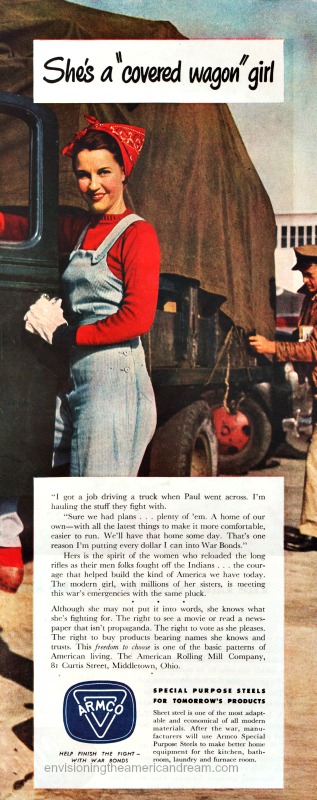
This modern girl with millions of her sisters is meeting this wars emergencies with the same pluck as the pioneer gals. “Although she may not put it into words she knows what she’s fighting for. The right to see a movie or read a newspaper that isn’t propaganda. The right to vote as she pleases. The freedom to choose. Vintage ad ARMCO 1944
An ARMCO ad channeled the pioneer spirit referring to a female truck driver as a “covered wagon girl:”
“I’ve got a job driving a truck when Paul went across. I’m hauling the stuff they fight with’…Her’s is the spirit of the women who reloaded the long rifles as their men fought off the Indians…the courage that helped build the kind of America we have today.”
Of course this progressive idea that women could perform all kinds of work had less to do with feminism and everything to do with patriotism.
Femininity on the Front Line
Of course some worrywarts were concerned that femininity would be a casualty of war.
Even as Rosie manned up she didn’t want to lose her feminine appeal. Keeping herself attractive was her patriotic duty. As Uncle Sam put it “Beauty is Miss Americas Badge of Courage.”
Rosie needed to remain pretty and feminine for the boys to boost their morale and give em’ something to fight for, preserving herself exactly as he remembered it.
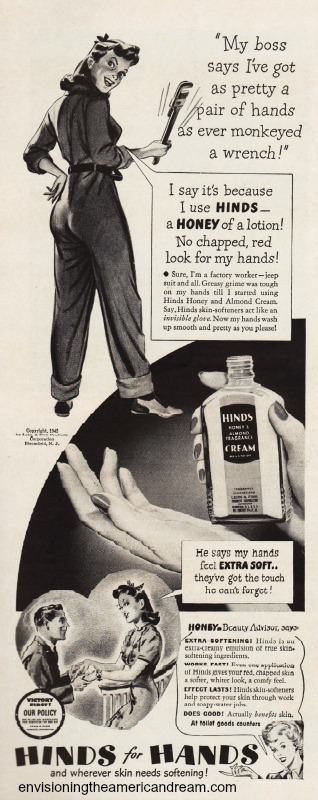
For hands he loves to touch. “Sure I’m a factory worker- jeep suit and all. But with Hinds my hands are as pretty as you please.” Vintage ad Hinds Hand Cream 1942
I Enjoy Being a Girl
No woman wanted to risk losing her femininity by taking on manly jobs so reassuring ads appeared to alleviate that fear.
These ads not only promoted confidence in woman’s ability to do a man-sized job but emphasized that femininity was not incompatible with hard, high pressure work a theme that also assured the public that inhabiting masculine roles did not destroy her womanliness.
In a 1943 ad, North America Aviation introduced us to lovely Jackie Maul a former model whose job reading blueprints clearly didn’t destroy her sex appeal or womanliness. The reader is reassured: “She still loves flowers hats veils, smooth orchestras and being kissed by a boy who’s now in North Africa.”
“What ! An artist’s model building a bomber,” the headline for this ad asks incredulously.
“Sounds unlikely doesn’t it? But if you walked through the big North American plants you’d be thrilled at the way hundreds of women like those pictured here are handling big important parts of the job of making airplanes.”
“The lovely girl at the drawing board is Jackie Maul onetime model for John Powers. She is one of many career women- former secretaries singers milliners and others- whose new careers at North American. Other women are housewives-and good ones too.”
“Here you will find wives, sisters, sweethearts ( and a few widows) of men fighting for freedom.
“Today every woman can be proud of her own contribution to the winning of the war”
Rosie the Riveter Dresses For Success
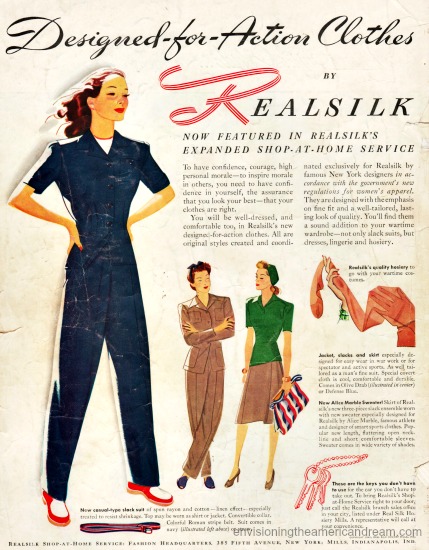
The copy for this vintage 1942 Realsilk ad reads: “To have confidence, courage high personal morale to inspire morale in others, you need to have confidence in yourself the assurance that you look your best that your clothes are right. Created by famous NY designers in ‘accordance with governments new regulations for women’s apparel.”
A frilly frock or peek a boo hairdo had no place in the factory floor, natch. Sweater set wearing sisters were promptly sent home from the plant because curve hugging sweaters were forbidden on “moral grounds” i.e. too distracting.
Even more of a work hazard was the long peekaboo hairstyle popularized by Veronica Lake. The long tresses could easily be ensnared in machines so as a result hair was ordered tied up in turbans or bandanas. As a patriotic gesture and in solidarity to her working sisters, Miss Lake switched to an upswept due for the duration.
So Angora sweaters and silk undies were put in mothballs for the war in exchange for more utilitarian work uniform as practical and hard-working as they were.
Real Silk, a shop at home service made famous for their luxurious pre war silk stockings switched gears and offered work clothes designed for action…just not the sexual kind!. These were clothes designed to inspire morale in others.”
Underneath it All, You’re all Woman
“There’s a new woman today,” Munsingwear Underwear proudly announced in a series of ads, doing a mans job so that he may fight and help finish the war sooner. With that in mind they created a new Line of Action undies called “Fighting Trims”just for working women
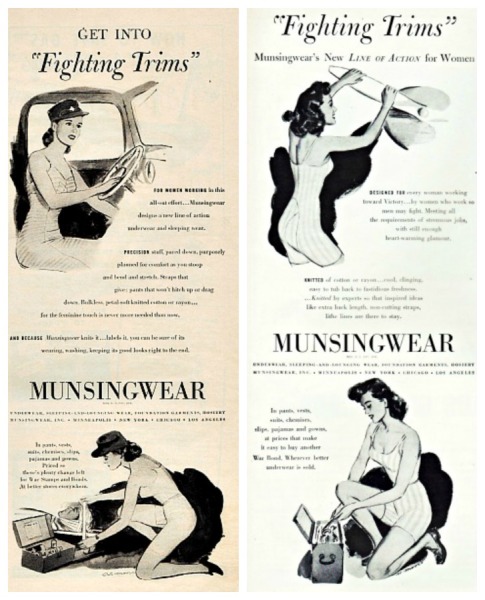
“Designed for every woman working towards victory by women who work so men may fight. Meeting all the requirements of strenuous jobs with still enough heart warming glamor.” Part time or full-time women will do it better with functional clothes. But still soft and feminine.” Vintage ad Munsingwear 1943
Equal Pay For Equal Work
If the work demanded women do men’s work it only made sense that women should receive equal pay for equal work. It was as simple as black and white
Despite the fact that this became national policy in November 1942 when the War Labor Board issued an order allowing employees to voluntarily raise women’s wages as much as necessary to bring them in line with mens, the order never trickled down to many smaller companies and the average female production worker still made about 40% less per week than did her male counterparts.
Of course there were some things a clever girl could do to get extra dough.
According to career advice offered in ads by Sal Hepatica manufacturer of Laxatives a gal would be wise to keep regular if she wanted to stay on the ball and get a raise.
In one 1943 ad we are introduced to 2 assembly line workers – Out of Luck Lucy whose constipation woes caused our sluggish missy to miss out on a raise, and smart Polly who takes a laxative and takes home a trophy and a juicy bonus.
Double Duty
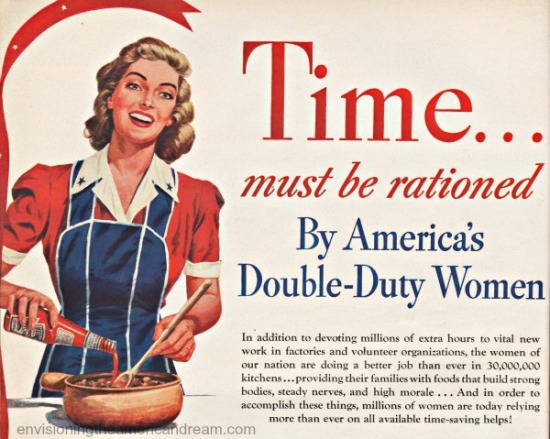
These ads encouraged women to stick to their jobs despite the demands of a 2 job life style. Vintage ad Heinz 1942
Like today, a working woman had to do double duty…building a plane and running a home.
The age-old question of whether a woman could truly balance a job and home was answered during the war with a resounding yes!
You betcha she could, the media crowed.
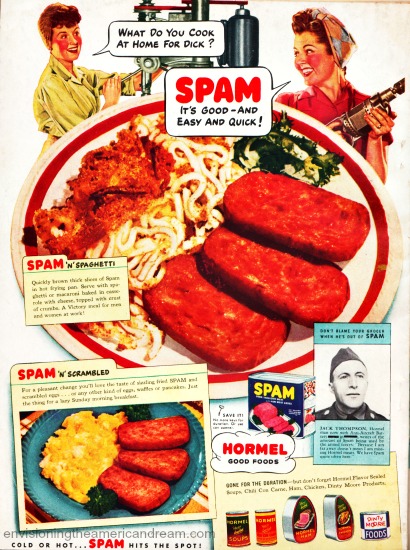
Even if she was lucky to have a husband at home women ended up carrying nearly all the care-giving responsibility. When Rosie returned each day from the great army of women soldiers of production she became a soldier of the kitchen. Vintage ad Spam 1943
Ads regularly reassured a doubting public that pulling women out of the home to join the work force would not damage family life, congratulating the homemaker for fulfilling obligations at home and on the job. Children and hubby would still be well take care of.

“Practically every woman in America is working 2 shifts,” explains the 1943 ad for Swifts. “Lots of us in addition to our war work still have our old job at home and what a job that is! ‘Last years problems in homemaking and meal planning seem like child’s play,’ says Mary Hoffman Miss Victory. Swifts franfurts come to her rescue save many a minute in trying job of wartime meal planning”
These ads helped to sweep aside old prejudices gently stowing them away for the duration, only to be taken back out of mothballs at war’s end.
Next: Operation June Cleaver
With victory in sight Rosie The Riveter would be unceremoniously handed her pink slip pushed out of the work force
Copyright (©) 2015 Sally Edelstein All Rights Reserved
You Might Also Enjoy:






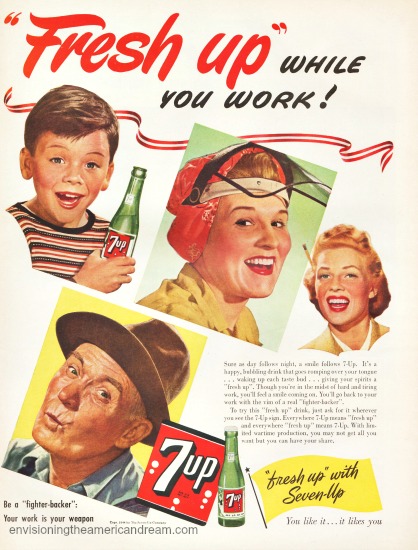
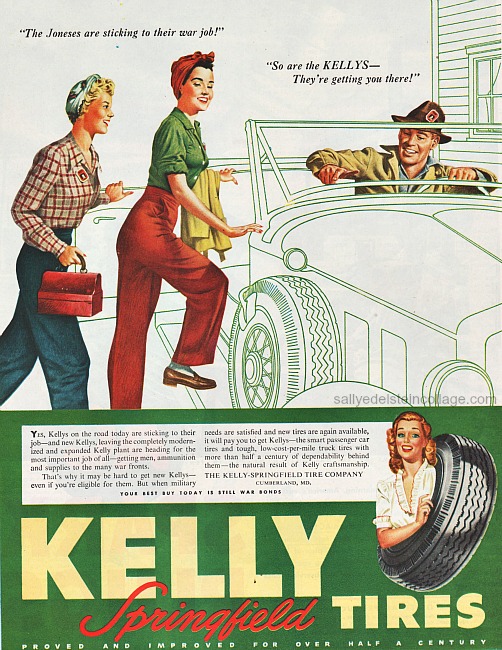


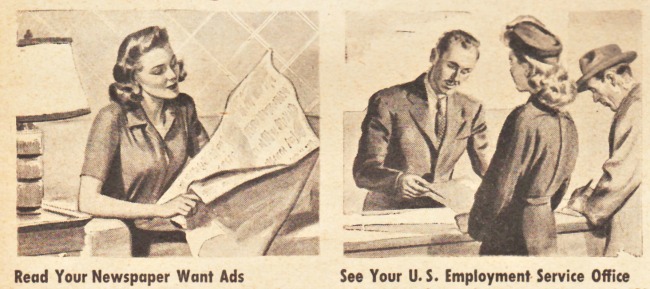

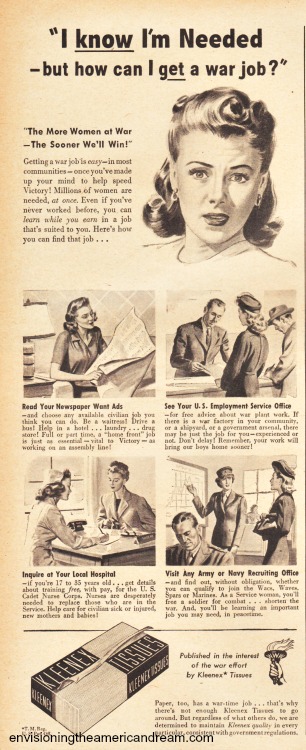


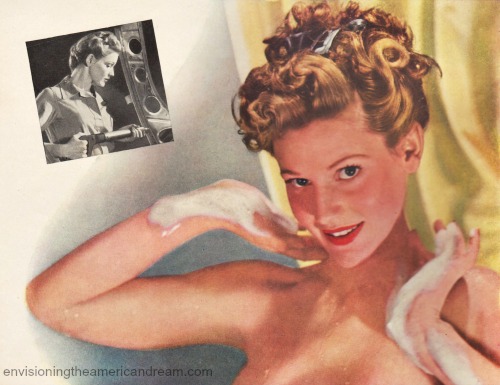
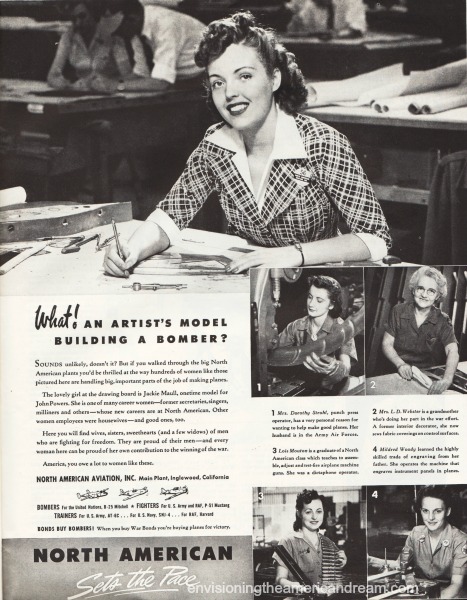
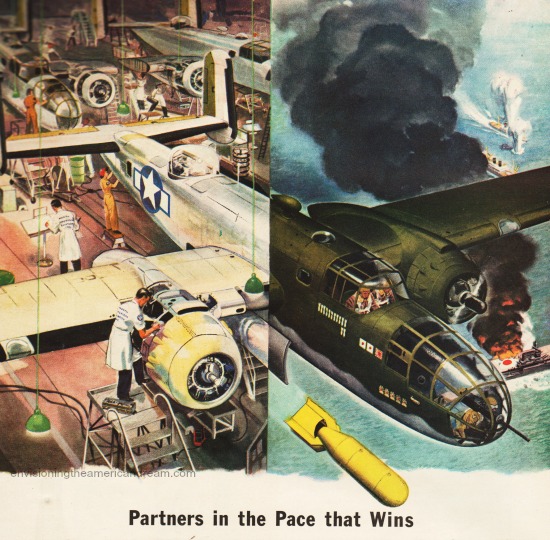
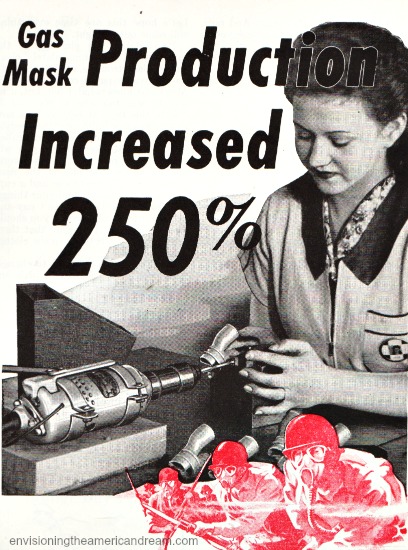


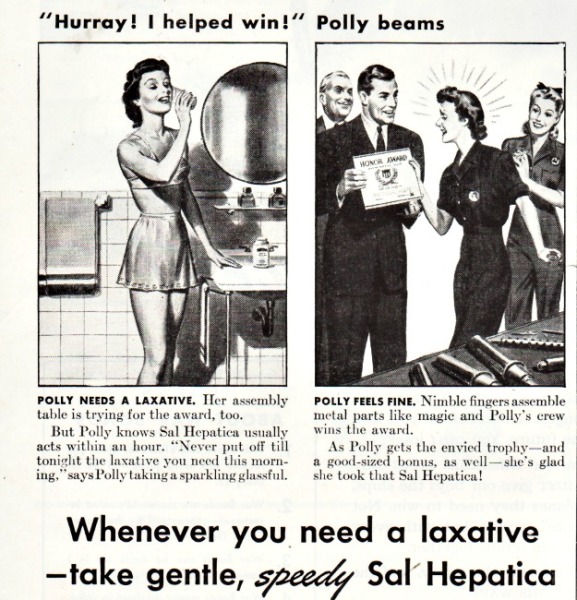




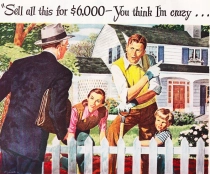
Amazing amount of research and organization putting this post together. All I can say is, WOW!
LikeLiked by 1 person
Thanks, it was a labor of love and so glad you enjoyed it.Because its women’s history month its that time of year we remembered women and their accomplishments, struggles and gains.
The recent ad campaign from NoCeilings.org where for one day women disappeared from ads,magazine covers and billboards reminded women “we’re not there yet” was powerful statement. I wanted to call attention to an important time when working womem were indeed almost “there,” praised in the media, only to be unceremoniously sent back home after the war and they weren’t needed.
LikeLike
Pingback: Great Images, Just a Click Away at “Envisioning the American Dream” | witness2fashion
Thanks for the mention!
LikeLike
It’s great seeing that the vintage advertising world did something good, that they weren’t ALWAYS evil. Now if only they brought the message of these ads back today!
LikeLike
Couldn’t agree more!
LikeLike
Really great history lesson. And Rosie laid down some things that were to come. No longer would women settle for just being a housewife. Because of her, women became astronauts, engineers, computer scientist, film directors, and so many more careers. The woman of today can see herself as running a corporation or being President of the United States.
LikeLiked by 1 person
All true, but there was a large campaign to get women back to their domestic roles and out of the workforce right after the war ended. I will be talking about that in the next post
LikeLiked by 2 people
It’s hard to put jack back in the box once he’s out.
LikeLiked by 1 person
Don, you’d be surprised how successful, what I call “Operation: June Cleaver” was
LikeLiked by 2 people
Pingback: Operation June Cleaver | Envisioning The American Dream
One thing we forget when we see these ads is that they were aimed at the Middle Class. Poor women always worked. They had no choice. My mother worked in a cotton mill. She also picked cotton. She was a single parent and had two kids to feed. Unfortunately we see little that celebrates their lives. I wish Ken Burns would do a series on the lives of those at the bottom.
LikeLiked by 1 person
Thank you for bringing up a very important point. The perspective shown here is decidedly white, middle class, and does not address the legion of women who had to work to support their family. Those women were real unsung heroes long before the war forced others into the factories. It would be a great subject for a documentary indeed.
LikeLiked by 1 person
Pingback: Marriage and Career- You Can Have It All | Envisioning The American Dream
Reblogged this on Girl on Fire.
LikeLike
My mom always worked from the time she was
18. Even after she had kids she always worked,
we were a family of factory workers. In the 50’s
my dad in no way could have supported the
family on just his income.
LikeLike
Pingback: Operation June Cleaver – Leah Love Online
Pingback: Will Operation June Cleaver Be Deployed in 2020 | Envisioning The American Dream